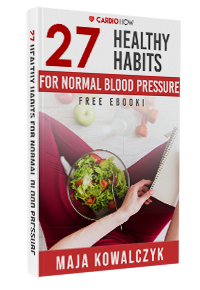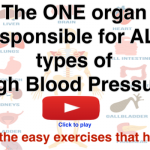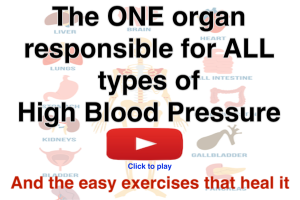The ONE organ responsible for high blood pressure.
The Most Effective Ways to Lower Blood Pressure

 High blood pressure (hypertension) is called the "silent killer" for a reason. It often produces no symptoms, but poses a serious risk of heart disease and stroke. And these diseases are among the leading causes of death in the United States.
Nearly half of US adults have high blood pressure.
Your blood pressure is measured in millimeters of mercury, which is mm Hg for short. Two numbers are involved in the measurement:
Systolic blood pressure. The top number represents the pressure when the heart pushes blood into arteries throughout the body.
Diastolic pressure. The lower number represents the pressure in the blood vessels between beats, when the heart fills and relaxes.
Blood pressure depends on how much blood the heart is pumping and how much resistance there is to blood flow in the arteries. The narrower your arteries, the higher your blood pressure.
Blood pressure lower than 120/80 mm Hg is considered normal. Blood pressure that is 130/80 mm Hg or higher is considered high.
If your blood pressure is above normal, but below 130/80 mm Hg, you fall into the elevated blood pressure category. This means that you are at risk of developing high blood pressure.
The good news about elevated blood pressure is that you can make changes that will significantly lower it and reduce your risk without the need for medication.
High blood pressure (hypertension) is called the "silent killer" for a reason. It often produces no symptoms, but poses a serious risk of heart disease and stroke. And these diseases are among the leading causes of death in the United States.
Nearly half of US adults have high blood pressure.
Your blood pressure is measured in millimeters of mercury, which is mm Hg for short. Two numbers are involved in the measurement:
Systolic blood pressure. The top number represents the pressure when the heart pushes blood into arteries throughout the body.
Diastolic pressure. The lower number represents the pressure in the blood vessels between beats, when the heart fills and relaxes.
Blood pressure depends on how much blood the heart is pumping and how much resistance there is to blood flow in the arteries. The narrower your arteries, the higher your blood pressure.
Blood pressure lower than 120/80 mm Hg is considered normal. Blood pressure that is 130/80 mm Hg or higher is considered high.
If your blood pressure is above normal, but below 130/80 mm Hg, you fall into the elevated blood pressure category. This means that you are at risk of developing high blood pressure.
The good news about elevated blood pressure is that you can make changes that will significantly lower it and reduce your risk without the need for medication.
Here are 17 effective ways to lower blood pressure levels.

1. Get more active and exercise more
A meta-analysis of 65 studies suggests that aerobic and resistance exercise can significantly lower blood pressure, especially in men. As you regularly increase your heart rate and breathing, over time your heart becomes stronger and pumps with less effort. This, in turn, reduces pressure on the arteries and lowers blood pressure. Increasing activity levels can be as simple as- use of stairs
- Walking instead of driving
- doing housework
- cultivating the garden
- cycling
- practicing team sports
- Just do it regularly and work up to at least half an hour a day of moderate activity.

2. Lose weight if you are overweight
If you are overweight, losing 5 to 10 pounds can lower your blood pressure. In addition, you will lower your risk of other potential medical problems. A review of several studies reported that weight-loss diets lowered blood pressure by an average of 3.2 mm Hg diastolic and 4.5 mm Hg systolic.
3. Limit sugar and refined carbohydrates
Many studies show that limiting sugar and refined carbohydrates can help you lose weight and lower blood pressure. Sugar, especially fructose, can increase blood pressure more than salt, according to one 2014 review. In trials lasting at least eight weeks, sugar raised blood pressure by 5.6 mm Hg diastolic and 6.9 mm Hg systolic. A 2020 study comparing various popular diets found that for people with higher body weight or obesity, low-carb and low-fat diets lowered diastolic blood pressure by an average of about 5 mm Hg and systolic blood pressure by 3 mm Hg after 6 months. Another benefit of a low-carb, low-sugar diet is that you feel fuller longer because you consume more protein and fat.
4. Eat more potassium and less sodium
Increasing potassium intake and limiting salt can also lower blood pressure. Potassium is a double winner: It reduces the effects of salt in your system and relieves tension in blood vessels. However, potassium-rich diets can be harmful to people with kidney disease, so talk to your doctor before increasing your potassium intake. It's easy to eat more potassium. So many foods are naturally high in potassium. Here are a few of them:- Low-fat dairy products such as milk and yogurt
- fruits such as bananas, apricots, avocados and oranges
- Vegetables such as sweet potatoes, potatoes, tomatoes, greens and spinach.
- low sodium foods
- fruits and vegetables
- low-fat dairy
- full grain
- fishes
- poultry
- fasola
- less sweets and red meats

5. Eat less processed food
Most of the extra salt in your diet comes from processed foods and foods from restaurants, not from your salt shaker at home (18Trusted Source). Popular high-salt items include:- delicatessen meats
- canned soups
- pizza
- chips
- other processed snacks.

6. Quit smoking
It can be difficult to do, but it's worth it: Quitting smoking is good for your all-around health. Smoking causes an immediate but temporary increase in blood pressure and heart rate. In the long term, the chemicals in tobacco can raise blood pressure by damaging blood vessel walls, causing inflammation and narrowing arteries. Hardened arteries cause higher blood pressure. The chemicals in tobacco can affect blood vessels even when you are around second-hand smoke. The study found that nonsmokers who were allowed to go to smoke-free restaurants, bars and workplaces had lower blood pressure than nonsmokers in areas without smoke-free policies for public places.
7. Reducing excessive stress
We live in stressful times. Workplace and family demands, national and international politics all contribute to stress. Finding ways to reduce your own stress is important for your health and blood pressure. There are many ways to effectively relieve stress, so find what works for you. Practice deep breathing, go for a walk, read a book or watch a comedy. Daily music listening has also been shown to lower systolic blood pressure. A 20-year study found that regular sauna use reduced death from heart-related events. And one small 2015 study found that acupuncture can lower both systolic and diastolic blood pressure.
8. Try meditation or yoga
Mindfulness and meditation, including transcendental meditation, have long been used and studied as methods to reduce stress. Yoga, which commonly includes breath control, posture and meditation techniques, can also be effective in reducing stress and blood pressure. A 2013 review of yoga and blood pressure found an average decrease in blood pressure of 3.62 mm Hg diastolic and 4.17 mm Hg systolic compared to those who did not exercise. Studies of yoga practices that included breath control, posture and meditation were almost twice as effective as yoga practices that did not include all three.
9. Eat some dark chocolate
Yes, chocolate lovers: Dark chocolate has been shown to lower blood pressure. But dark chocolate should be 60 to 70 percent cocoa. A review of studies on dark chocolate found that eating one to two squares of dark chocolate a day can help lower the risk of heart disease by lowering blood pressure and inflammation. The benefits are believed to come from flavonoids present in chocolate with more cocoa solids. Flavonoids help dilate, or widen, blood vessels.
10 Try these healing herbs
Herbal medicines have long been used in many cultures to treat a variety of ailments. Some herbs have even been shown to possibly lower blood pressure. However, more research is needed to identify the dosages and ingredients in herbs that are most useful. Always consult your doctor or pharmacist before taking herbal supplements. They may interfere with prescription medications. Here is a partial list of plants and herbs that are used by cultures around the world to lower blood pressure:- czarna fasola (Castanospermum australe)
- koci pazur (Uncaria rhynchophylla)
- See celery juice (Apium graveolens)
- Chinese hawthorn (Crataegus pinnatifida)
- ginger root
- olive dodder (Cuscuta reflexa)
- Indian corn (psyllium blond)
- bark of maritime pine (Pinus pinaster)
- river lily (Crinum glaucum)
- Raspberry (Hibiscus sabdariffa)
- Sesame oil (Sesamum indicum)
- extract of tomato (Lycopersicon esculentum)
- tea (Camellia sinensis), especially green tea and oolong tea
- bark of the umbrella tree (Musanga cecropioides)

11. Ensure a good, restful sleep
Your blood pressure usually drops during sleep. If you don't sleep well, your blood pressure may be affected. People who experience sleep deprivation, especially those in middle age, have an increased risk of high blood pressure. For some people, getting a good night's sleep is not easy. Here are some of the many ways to help you get a restful night's sleep:- Try to establish a regular sleep schedule.
- Spend time relaxing before bedtime
- Exercise during the day.
- Avoid naps during the day.
- Get comfortable in your bedroom.

12. Eat garlic or take supplements with garlic extract
Fresh garlic or garlic extract are widely used to lower blood pressure. The meta-analysis showed that for people with high blood pressure, garlic supplements reduced their systolic blood pressure by up to about 5 mm Hg and reduced diastolic blood pressure by as much as 2.5 mm Hg. According to a 2009 clinical trial, a timed-release garlic extract preparation may have a greater effect on blood pressure than regular tablets with garlic powder.
13. Eat healthy foods high in protein
A long-term study completed in 2014 found that people who ate more protein had a lower risk of high blood pressure. For those who ate an average of 100 grams of protein a day, there was a 40 percent lower risk of having high blood pressure than those on a low-protein diet. Those who also added regular fiber to their diet saw up to a 60 percent reduction in risk. However, a high-protein diet may not be for everyone. People with kidney disease may need to be careful. It is best to discuss this with your doctor. Consuming 100 grams of protein per day on most types of diets is fairly easy. High-protein foods include:- Fish, such as salmon or canned tuna in water
- eggs
- poultry, such as chicken breast
- beef
- beans and legumes such as kidney beans and lentils
- nuts or peanut butter, such as peanut butter
- chickpeas
- cheese, such as cheddar

14. Take these supplements to lower blood pressure
These supplements are readily available and have shown promise in lowering blood pressure: Green unsaturated omega-3 fatty acids Adding omega-3 polyunsaturated fatty acids or fish oil to your diet can bring many benefits. A meta-analysis of fish oil and blood pressure showed a mean reduction in blood pressure in people with high blood pressure of 4.5 mm Hg systolic and 3.0 mm Hg diastolic. Whey protein This protein complex derived from milk may have several health benefits in addition to possibly lowering blood pressure. Magnesium Magnesium deficiency is associated with higher blood pressure. A meta-analysis showed a small reduction in blood pressure with magnesium supplementation. Citrulline Oral L-citrulline is a precursor to L-arginine in the body, a protein builder, which can lower blood pressure.
15. Drink less alcohol
Alcohol can raise your blood pressure, even if you are healthy. It is important to drink in moderation. According to a 2006 study, alcohol can raise blood pressure by 1 mm Hg for every 10 grams of alcohol consumed (38). A standard drink contains 14 grams of alcohol.
16. Consider cutting back on caffeine
Caffeine raises blood pressure, but the effect is temporary. In a 2017 study, the systolic blood pressure of 18 participants was elevated for 2 hours after they drank 32 ounces of either a caffeinated drink or an energy drink. Blood pressure then dropped faster for participants who drank the caffeinated beverage. Some people may be more sensitive to caffeine than others. If you are sensitive to caffeine, you may want to limit your coffee intake or try decaffeinated coffee.









